JACKIE BROWN
NOT JUST A THEATRE ORGANIST
-oOo-
THE HOME ORGAN
1935 TO THE PRESENT DAY
by
ANDREW GILBERT
-oOo-
 Andrew Gilbert
Andrew Gilbert
-oOo-
There were, at any one time in the ‘heyday’ of the home organ (usually taken to be the late 1960s to the mid 1980s), over 40 different makes offering well over 200 models between them. Over those years, that makes for a total of well over a thousand models and it’s therefore impossible to cover them all. That would require a whole book, which several people have asked me to write and I have made a start! So I can only cover the basics of some of those makes in this article.
Although the idea of creating music by electrical methods had been around since the late 1800s, with Thomas Cahill’s massive but rather impractical ‘Telharmonium Dynamophone, it’s nevertheless true to say that Laurens Hammond really started the electronic organ business in 1935 with the model A, and the variants and developments that followed in what’s often referred to as the A/B/C series of console models. Hammond originally intended his organ to be a low cost replacement for a church pipe organ, but it soon attracted interest from people like Henry Ford and George Gershwin.
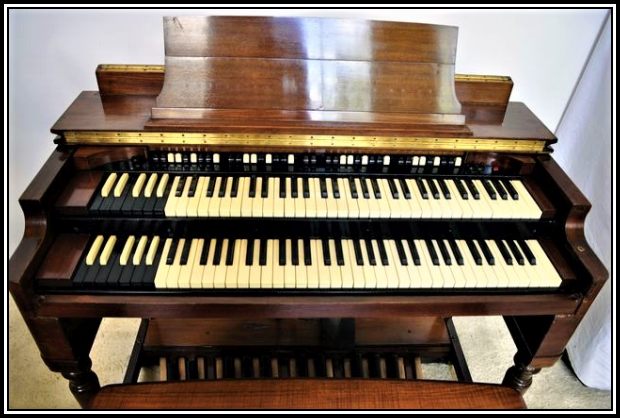 Hammond Model A
Hammond Model A
Some theatre organists soon took to the instrument as something that they could take around with them for concerts as, although heavy, it was rugged and dependable. Indeed, the ‘limelight’ often went to these theatre style players including Rosa Rio and Ethel Smith and, later on, to the jazz and rock players like Jimmy Smith, Jimmy McGriff and Booker T. However, it’s worth stating that the real ‘stars’ of the Hammond organ world were the Hammond staff artistes like Eddie Layton and Rosemary Bailey in the USA, and Keith Beckingham, George Blackmore and Bryan Rodwell in the UK. And we should not forget the people who used the Hammond to develop the principles of teaching home organ, like Porter Heaps. These were the people that worked with the Hammond dealers to make Hammond so popular with the general public – thus increasing the number of home organ players manyfold! We must also consider the role of the hundreds of Hammond Organ Societies set up around the world to promote the Hammond at a local level. This soon led to the formation of even more local organ societies that were not tied to any particular make. All this exposure further developed the market.
 Eddie Layton at Hammond
Eddie Layton at Hammond
As well as making organs which, as has often been said, were already easier to play than a piano – at least initially – due to their sustained tones, Hammond did also make some ‘easy play’ instruments like the model S chord organ, where an accompaniment chord could be played with just one finger on accordion type buttons. But in 1970, Hammond released the first true easy play instrument in the shape of the single manual ‘Piper Autochord’. By selecting a rhythm and holding down a simple chord, the instrument would play a rhythmic backing. This was very quickly copied by almost every other manufacturer, either as a similar rival instrument, or by incorporating the auto-play features into their two manual organs.
Perhaps the biggest boost of all to the fledgling home organ business was the introduction of the model M in 1948. Hammond, keen to produce a smaller sized instrument, looked at the keys and pedals that the home hobby player was using and simply removed the ones that he felt they didn’t need! The result was the ‘spinet organ’. In the home organ world, that usually means an organ with short, staggered keyboards of between 37 and 49 notes and a short pedalboard of just 13 notes. The M, and its later variants, the M-2 and M-3, quickly established themselves as Hammond’s best selling instrument.
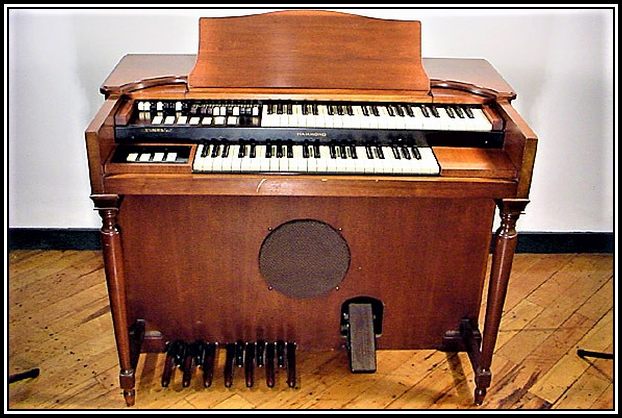 Hammond Model M-3
Hammond Model M-3
Hammond, like all makes, evolved their instruments over the years with some instruments like the B-3 becoming classics and others becoming almost iconic, like the ‘X-66’. In the early 1970s they dropped the electro-mechanical tonewheel generator that had powered most Hammonds for almost 40 years in favour of the latest integrated circuit electronics of the day, with instruments like the ‘Concorde’, ‘Regent’ and ‘Cougar’. Many more models would follow, from the lowly ‘Dolphin’ series to the top-of-the-line ‘Aurora Classic’ and Elegante’. The new electronics allowed Hammond to retain their famous drawbars and add the extra sounds and features offered by their rivals.
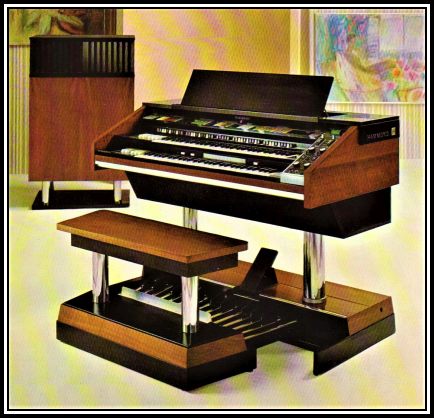 Hammond X-66
Hammond X-66
 Hammond Concorde
Hammond Concorde
Hammond changed ownership a couple of times, having virtually gone out of business around 1984/85, and are currently owned by Suzuki in Japan. Hammond-Suzuki produced a range of spinet and console models, including some dedicated church organs, up to the early 2000s, culminating with the modular XE series and the XH272 ‘Elegante’. But with the decline in the home organ market they started to concentrate exclusively on the professional market and now produce instruments in their ‘New B-3’, XK and SK ranges.
The second name in American home organs has to be Lowrey and their development origins go back as far as 1927. In 1949 they produced the ‘Organo’, an attachment that could add organ type sounds to a piano, but it was 1957 before they produced their first true home organ, the Model S ‘Berkshire’. The electronics they used – vacuum tubes at first and then transistors from 1963 – allowed them to produce sounds and have features that Hammond simply could not offer and they soon became a serious rival.
Like Hammond, their organs developed over the years, but probably at a faster rate due to the rapid advances in the electronics they were using. Models like the early ‘Heritage’ spinets and ‘Lincolnwood’ console models soon became classics and are still sought after today, almost 60 years later!
 Lowrey DSO-1 Heritage
Lowrey DSO-1 Heritage
Lowrey had a couple of exclusive and patented features in the early days. ‘Glide’ was a kick switch on the expression pedal that lowered the pitch of the organ by about a semitone and, with a little practice, the player could emulate the slide of a trombone, gypsy violin or Hawaiian Guitar. Wurlitzer soon copied this feature exactly, calling it ‘Slide’, and I am told that a costly court case rapidly followed.
The other feature was AOC. Standing for ‘Automatic Orchestra Control’ at first and later ‘Automatic Organ Computer’, it added the notes of a left hand chord to a single melody note played by the right hand. This made a big sound and allowed the home player to sound very professional. Other makes, perhaps mindful of the Glide/Slide situation, did not copy this feature until the patents expired in the early 1980s. After that, every make added it, with a variety of names such as Harmonizer, Technichord, Wersichord, MOC and AMC.
Lowrey also had a feature called ‘Virtuoso’. Available as an option of some models, and tied into the AOC circuitry, this was an extra keyboard with no raised black keys, set just behind the upper manual. If a chord was held on the lower manual and a finger run across the Virtuoso keyboard, the organ produced a flawless arpeggio of the chord being held. This first appeared in 1966 at the exact same time as Hammond put a similar ‘arpeggiator’ onto the X-66. The device was not patented by either company and many other makes soon added the feature to their organs.
 Lowrey TLOK-V with Virtuoso
Lowrey TLOK-V with Virtuoso
Lowrey introduced more and more features into their organs and also produced their rival to the ‘Hammond Piper Autochord’ in the shape of the ‘Teenie Genie’. One of the biggest ‘landmark’ instruments in the history of the home organ was the Lowrey MX-1 in 1980. This was the first organ to offer fully orchestrated backing patterns, something that would become the ‘norm’ on all makes of organs and keyboards in the following years.
 Lowrey MX-1
Lowrey MX-1
Lowrey production would continue in the USA until 1988 when the company was bought – some would say rescued – by Kawai Japan. The Chicago factory staff still designed, specified and voiced the organs, but the electronics and the raw, unedited, sounds were supplied by Kawai. Production was initially in Chicago, before switching to Kawai’s facilities in the Far East. Kawai and Lowrey worked together until the end of 2018, with the last new model made being the ‘Aria Pro’. Third parties have bought some of the rights to the Lowrey products (but not the name itself) and there are now upgrades available for certain older models.
 Lowrey Aria Pro
Lowrey Aria Pro
Wurlitzer, Conn, Gulbransen, Kimball, Thomas and Baldwin were among the other main makes of American home organs, each with their own individual sounds and features. Thomas had their sparkling ‘Champagne Tibia’ voices, Baldwin had rich flutes and the wonderful ‘Muted Reed’ – a wah-wah brass sound controlled by the expression pedal. Gulbransen were the first to incorporate a realistic piano voice and a built-in Leslie rotary speaker system. Wurlitzer introduced a built in synthesizer as a third manual with the model 4037. Conn’s larger instruments used separate oscillators for every note of the organ, which allowed it to produce a very rich classical or theatre organ sound. My mentor Jackie Brown was very fond of the three manual model 580, as was I!
 Conn 580
Conn 580
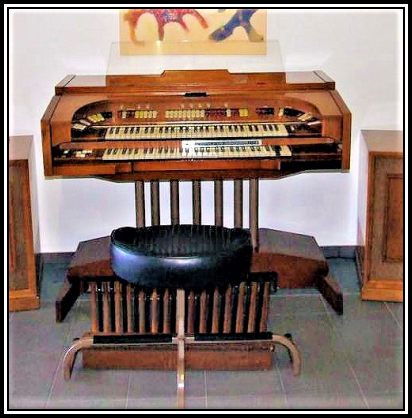 Thomas Electra
Thomas Electra
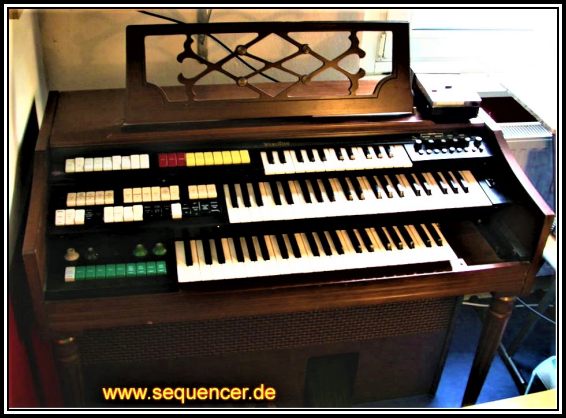 Wurlitzer 4037
Wurlitzer 4037
In Italy, Farfisa was an electronics manufacturer, formed in Osmio, following the merger of three accordion companies. The name is an abbreviation of Fabbriche Riunite Fisarmoniche Italia S.p.A, which translates to United Italian Accordion Factories.
In the late 1950s, the company started producing ‘combo’ organs for stage use, in response to the success of the British made Jennings and Vox Continental models. Compact and lightweight (compared to the very heavy Hammonds) and usually on chrome stands, they became a staple in many bands of the 1960s. Popular models included the ‘Fast’, the ‘Compact’ and the later ‘Professional Duo’.
 Farfisa Professional Duo
Farfisa Professional Duo
But they also started to produce home organs in the mid 1960s, with models such as the ‘Ballata’ and the ‘Leader’. They would continue making ever improving instruments such as the ‘Buckingham’ and ‘Coronet’ well into the 1980s, though their last ranges of instruments were produced after their takeover by the Bontempi company and were perhaps not so well regarded.
 Farfisa Buckingham
Farfisa Buckingham
As well as Farfisa, Italy was home to a host of manufacturers, all in the Ancona area of the country. Elka and Orla were very popular, with Orla also producing organs for Hammond and Lowrey at times. Other makes included Welson, Eko, CRB, Solton and Elgam. Italian organs had the unfortunate reputation for unreliability for some years but the larger companies, faced with the exceptional reliability and quality of the Japanese organs, turned things around with some great sounding and reliable instruments.
 Elka 707 Crescendo
Elka 707 Crescendo
In Japan, Yamaha chose ‘Electone’ as their trademark for their range of electronic organs, though they were almost universally just called ‘organs’, even in Yamaha’s own brochures. The first Yamaha home organ was the small D-1 model, in 1959. The range slowly developed with smaller models in the B and C series as well as larger D series organs. These were all spinet models. Yamaha also built many full console models in their E series, as well as stage models with X in the model number, such as the EX-42 and ELX-1.
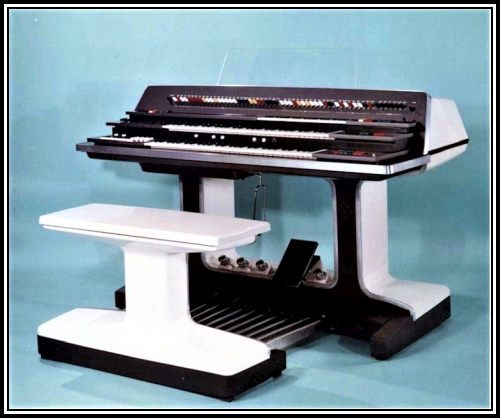 Yamaha EX-42
Yamaha EX-42
They would continue to produce an ever developing range of home organs into the 1990s, with the EL and AR series being the last that were exported world-wide. They still produce the ‘Stagea’ and ‘D-Deck’ series for the home and Asian markets and many of these superb organs have been imported privately by home players and professionals around the world.
 Yamaha ELS-02
Yamaha ELS-02
Also based in Japan, the Kawai company started making their home organs a year later than Yamaha, starting in 1960. Their trademark was ‘Dreamatone’, but this seemed to be used infrequently and only for the home market. It certainly appeared on some early models, then on the T-30 concert organ in 1979 and finally for their last series of organs the ‘Dreamatone DT’ range. All the US and European literature just called them ‘Electronic Organs’.
Although similar in some ways to Yamaha, Kawai organs had their own distinctive sound and features. In the late 1970s, Kawai, as well as the other Japanese makes, started employing their American and European players to help design and voice the instruments – including me at Kawai – and it’s true to say that this was a big step forward in tonal quality, becoming richer and, as we used to say back then, ‘more American’!
 Kawai DX900
Kawai DX900
Other makes of Japanese organs included JVC, with their Victron organs, Technics and Roland. JVC started in the early 1960s but never seemed to make it big outside of the home market. They – like many makes, in fact – quit the organ market in the early 1980s. Technics started as Panasonic/National, before adopting their ‘premium’ brand name and producing high quality instruments up to the late 1990s. Roland were latecomers to the market, and produced their excellent and distinctive ‘Atelier’ series from the 1994 to the late 2010s. Known very much as a ‘player’s organ’, with less in the way of ‘bells and whistles’ than some makes, Roland Atelier organs always featured an extended lower manual that could be played as a piano.
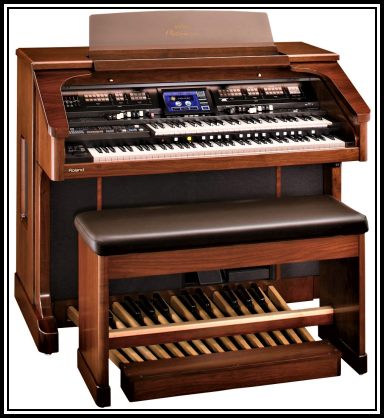 Roland AT900 Platinum
Roland AT900 Platinum
There were two major German makes, Wersi and Böhm, and these were initially offered in kit form. They had a very distinctive sound, with models like the W2 ‘Helios’ being popularized by the brilliant German organist, Klaus Wunderlich. As with all makes, they developed and improved greatly over the years and are still being made today. They are probably the most advanced home organs ever produced. They have a huge following in Continental Europe and the UK.
 Wersi Helios
Wersi Helios
There were three major Dutch makers, Phillips (Philicorda), RiHa and Eminent. All three produced distinctly different instruments, with the small Philicorda GM750 and its descendants becoming popular as a combo organ! But I cannot write this article without giving a very special mention to one organ in particular. This was the Eminent model 310u. A small organ in terms of its size, it was a giant in terms of the future of the home organ. It was the first practical home organ to incorporate the simulated sound of orchestral strings. (The huge Lowrey H25-3 model appeared around the same time and featured the ‘Freeman String Symphonizer’ unit but its complex and expensive electronics made it impractical for use in smaller organs.) The string ensemble technology used in the Eminent remained open for all makes to use and they most certainly did so! Within a year or two all home organs were becoming more and more orchestral/band based, with the organ sounds becoming just one part of the instruments’ sound palette. The home organ would never be the same again!
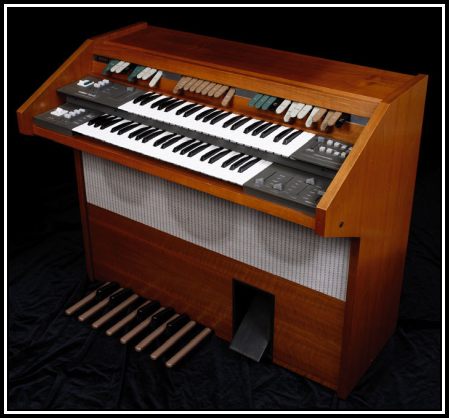 Eminent 310u
Eminent 310u
As I said at the start of this article, I have only just scratched the surface of the home organ industry. There were many more makes and models, and more ‘landmark’ developments than I have time and space for here – and I haven’t even touched on things like the theatre organ models from companies such as Allen and Rodgers. Watch out for the book!
© Andrew Gilbert, 2022
—oooOooo—
